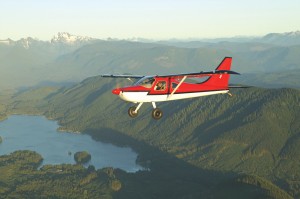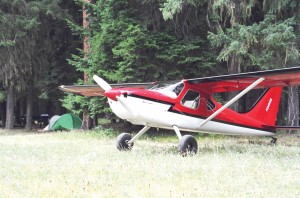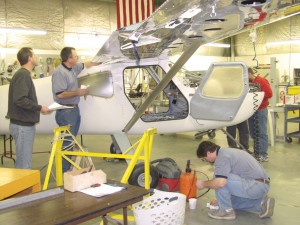By Terry Stephens
Glasair Aviation President Mikael Via has a big surprise for the build-it-yourself kit plane industry. The company’s new in-factory assembly program is designed especially for pilots who want to create and fly their own planes in a couple of weeks, instead of a couple of years or more. Via will announce a new world of flying opportunities for pilots who want to build their own planes at the 32nd Annual Sun ‘n Fun Fly-In, to be held April 4-10 in Lakeland, Fla. He calls the first-in-the-industry program “Two Weeks to Taxi.”

A Glasair Sportsman 2+2 flies over the Cascade Mountains near the firms’ production plant in Arlington, Wash.
Glasair, based in Arlington, Wash., is one of the world’s largest kit plane manufacturers, with more than 2,500 kits in the field and more than 1,200 planes flying. The company will expand its build-at-the-factory option to include building its popular Sportsman 2+2 and flying away in only two weeks. The program is expected to be ready for customers by August.
“Based on a survey of our customers and a market analysis, we determined there’s a bigger market for our planes if we can provide a single price and guide owners through the building process so they can fly sooner,” Via said.
Because kit plane builders often spend years putting their planes together, Glasair created a customer assembly center at the company’s factory in late 2004 for buyers who wanted to dramatically shorten the construction time. But when kit planes are finished, including Glasair’s models, they still lack the engine, propeller, avionics and wiring, making it impossible for buyers to figure the exact cost of the entire plane. That’s the problem Via wants to solve with his newest venture.
“For buyers who spent a couple of weeks with us at the factory, using our tools and advice from our production crew, the results were amazing,” he said. “But they still had to trailer the plane back home and source the rest of the things needed to make it fly.”
Glasair’s “Two Weeks to Taxi” program includes in-factory assembly, the power plant, avionics, and prop and wiring, producing a plane ready for taxiing and test flights, all at one total price. Via said the immersion experience at the factory and opportunity to fly Glasair’s corporate plane, to learn about flying characteristics of the Sportsman 2+2, add immeasurably to both flying enjoyment and safety, once the owner leaves with the plane.
He said that although people like the assembly process, they’re eager to get to the flying part. His newest program helps them to do that. Also, by setting a firm price, Glasair reaches a broader group of potential buyers.
“We call it bundled pricing,” Via said. “Before, there was just the kit price for the fuselage, wing and tail; that’s how it was done. You didn’t know the complete price, with the engine, avionics, upholstery and such, until you were through. We’re changing the industry by offering a total price for everything, upfront. We believe a large segment of the aviation community would buy a Glasair kit if they knew the total price before they began.”
Many options and variables are in Glasair’s kits, but complete pricing for the Sportsman listed on Glasair’s website presently is $39,950, plus $1,100 for shipping. Various choices of landing gear, electric elevator trimming and other items change the basic price. Those prices, like all kits in the market today, don’t include the unknown costs of the engine, avionics and other items.
“We already have a large part of the kit plane market and that’s hard to expand because the market is limited,” Via said. “So we decided to grow the size of the whole pie by bringing in new customers who hadn’t seriously considered buying a kit plane before. We think this new plan will greatly expand our whole market.”
If the experience of Marc Cook, KITPLANES editor-in-chief, is any indication, Glasair has hit on a big new idea that should be popular with general aviation pilots. In January, after narrowing his choice for a corporate kit plane to Glasair’s Sportsman 2+2, he participated in a prototype test of the Consumer Assembly Center and the “Two Weeks to Taxi” program. Because the first trial run through the whole program was a learning experience for Glasair, as well as Cook, it took him 18 working days at the plant, longer than expected for the regular process once it’s initiated in August.

Glasair Aviation’s popular Sportsman 2+2 is designed for a variety of uses, including recreational trips into mountain meadows for camping.
“I very much enjoyed the process,” Cook said. “The program is very well organized and choreographed. The genius of the program is that so much is done before the builder shows up. The first plane I built, a Pulsar XP, took me three years in my garage and then at the airport. I don’t think I’d ever want to build another one that way.”
He said 30 to 40 percent of the time compression comes from Glasair’s planning of the assembly process.
“Sixty percent comes from having all of the tools, jigs and parts for each stage of assembly laid out ahead of time,” he said. “Not just having them there, but organized for your use, with all the pages of the manual for that segment laid out with tools.”
Cook said that because he’d built one before, he had some understanding of the whole process.
“I know it’s really easy for a kit plane builder to get bogged down in small things and waste hours, days and weeks trying to feel their way through,” he said. “Here, you have people telling you what you need to do and how, watching you and giving one-on-one technical support.”
He said that’s done extremely well at Glasair and is important to the outcome.
“Ted Setzer and his crew were really knowledgeable,” he said. “A real benefit of the program is the experience of working with guys in the shop who can tell you a rivet isn’t quite right or that you messed something up and need to do it over.”
He recalls, in contrast, the experience of building his first plane. He remembers the wasted time “walking to the tool box or finding the hardware, the right bolts, trying to figure out the next step in the instructions.”
“It was an incredible waste of time, but that’s the way it’s always been done with kit planes,” he said.
By early March, he had logged 20 hours in the air with the plane, about halfway through his flight tests.
“It flies beautifully,” Cook said. “One big unknown was the performance of the engine and prop on this plane for the first time, one I chose myself rather than a stock engine from Glasair. I was hoping that more speed from the extra horsepower would be noticeable. It was more than that. I’m getting a cruise speed of 145 knots, about 10 better than the factory plane, and exceptional climbing performance that certainly exceeded my expectations.”
With a 180 horsepower engine, the top speed of the basic Glasair Sportsman 2+2 is 140 knots (161 mph), with a cruise speed of 135 knots at 75 percent power at 8,000 feet and a stall speed of 51 knots. The plane has a rate of climb of 1,950 feet per minute, a range of 767 miles at 8.5 gallons per hour and a service ceiling of 20,000 feet. The plane easily converts from a taildragger to a trike, has folding wings and can be built as a floatplane.
“The upfront cost may look like a big investment of time and money, but there’s a massive payback to the builder in the time savings, working with people who know the product and learning safety items and care of the airplane as you build it,” Cook said.
Via said that at the factory, the aircraft buyer does the assembly work in a way that meets both “the spirit and the letter of the FAA’s regulations that require the builder to do 51 percent of the construction.”
“I don’t know if the rest of the industry will follow us or not,” he said. “But we’re betting that because kit plane builders we’ve surveyed end up at 70 percent or more over their original budget, they’ll be attracted by a firm price and the opportunity to be flying in just a couple of weeks.”
Taking time for the factory assembly opportunity can be viewed as a vacation, too. The pilot will accomplish a lot but have fun doing it.

Marc Cook, editor of KITPLANES, works on his Sportsman 2+2 during a January session at Glasair’s Customer Assembly Center. A new program makes it possible for a Sportsman to be built at the plant in two weeks, from start to first flight.
“Many come to our assembly center for their vacation trip,” he said. “Wives even come. One of them brought things to read so she wouldn’t be bored while she indulged her husband’s flying interests. One day, our crew asked her to hold a part of the plane during the assembly. She got so interested she helped to build the rest of it and today she has her own pilot’s license.”
Via said Glasair realized that for most kit builders who work on their spare evenings and weekends, 80 percent of their time is spent doing things that “have nothing to do with accomplishing the task of getting the plane built.”
“We have a great manual but when you come to, say, assembling the elevator, you have to find the right parts in the 15 boxes we shipped to you, be sure you have the right tools for the work, know where they are and have an efficient work space,” he said.
Providing the Customer Assembly Center has attracted a lot of attention in the industry. That encouraged Glasair to improve on that timesaving option by adding the engine, avionics and other fly-away items, along with assembly space and a shop crew to oversee the process.

Glasair’s newest option is building a plane at its plant in Arlington, Wash., with an engine, avionics and everything needed to taxi out for a test flight in two weeks, all at a pre-set price. That’s a first for the kit plane industry.
“The kit plane industry is still evolving,” Via said. “It started in the sixties and seventies, when you could buy a set of plans, source all the materials, cut and shape pieces and assemble the aircraft in your garage or hangar. This was usually an extremely long process. That’s changed dramatically today.”
The changes began in 1980 when Tom Hamilton and Ted Setzer debuted the Glasair TD, the world’s first pre-molded composite kit aircraft, at EAA AirVenture Oshkosh and sold 150 kits that year. The manufacturer, Arlington-based Stoddard-Hamilton Aircraft Co., produced the Glasair series of kit-built planes in increasingly simplified kits that included more and more pre-built segments of the planes. “Jump-start” wings and fuselage options reduced building time by 50 percent by the late-1990s.
By 2000, however, the company’s low profit margins finally led to bankruptcy, although the planes themselves were increasingly more popular and easy to assemble and fly. The planes were so popular, in fact, that many creditors caught in the bankruptcy didn’t want their $30,000 deposits refunded. They just wanted the planes.
In 2001, Thomas W. Wathen, former chairman and CEO of Pinkerton’s Inc., bought the firm’s assets and formed Glasair Aviation LLC to continue production of the aircraft fleet, including the Glasair models and the GlasStar line that began in 1995. Wathen, a member of the EAA President’s Council, hired Mikael Via as its president and chief operating officer.

The Customer Assembly Center provides a factory environment for rapid assembly of this Sportsman 2+2.
Last April, Glasair provided another surprise to the crowds at Sun ‘n Fun, when Via delivered an “extreme makeover” of EAA’s GlasStar kit plane that has flown more than 3,000 young people in the Young Eagles program. Making a corporate investment of $35,000 worth of work and improvements, Glasair upgraded the interior and exterior appearance of the plane before returning it to service with EAA.
For more information about Glasair Aviation LLC and its variety of kits for high-performance single-engine aircraft, contact Alan Negrin or Harry DeLong at 360-435-8533 or visit [http://www.glasairaviation.com].

Glasair President Mikael Via (left) oversees work at the Arlington plant on a customer-built Sportsman 2+2. Owners build at least 51 percent of the plane to meet FAA regulations for kit plane construction.











